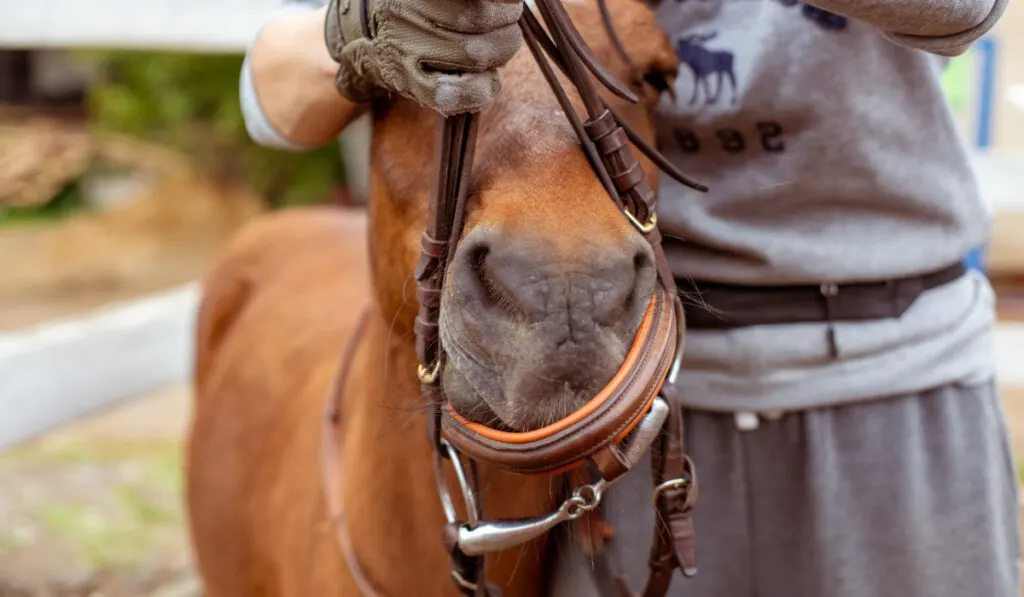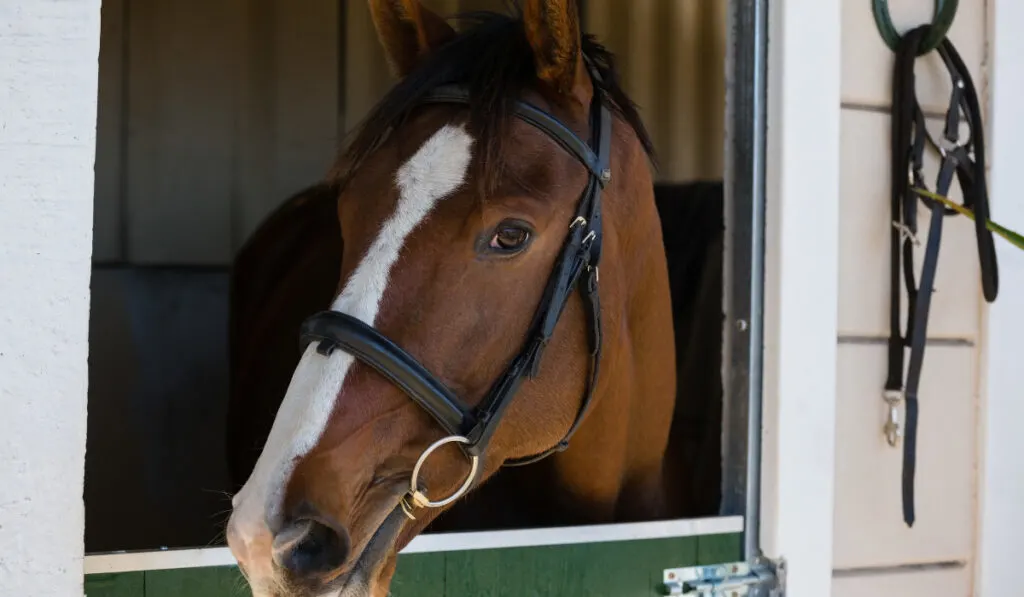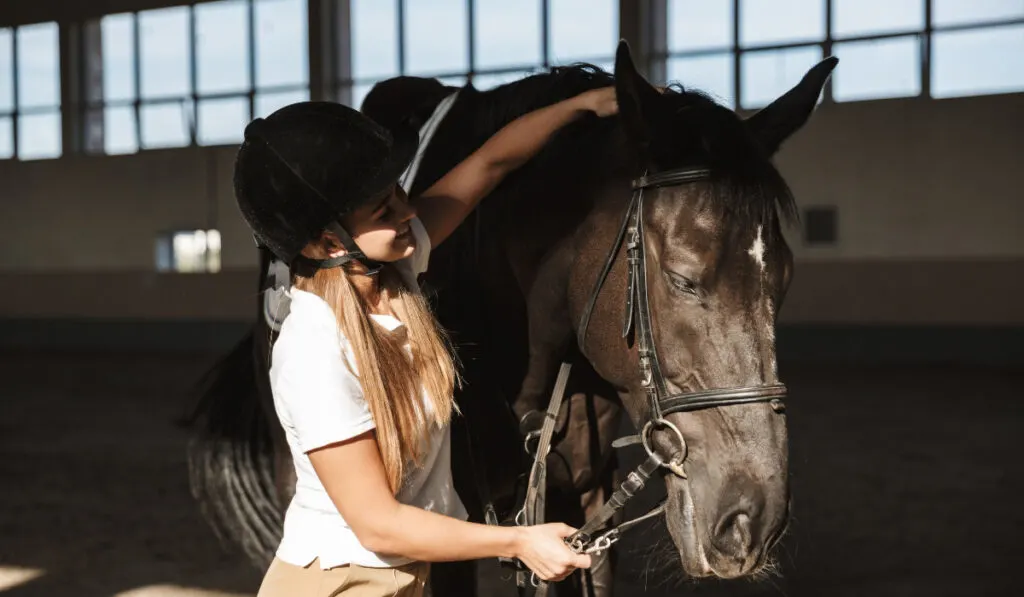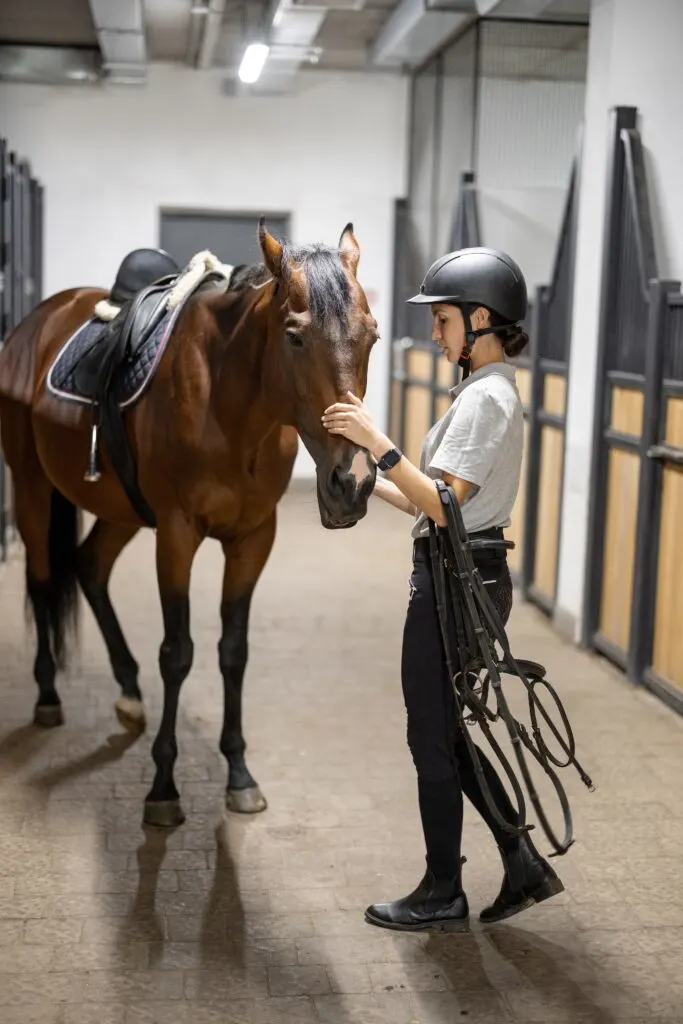Even though bridling a horse is a common part of the riding experience, you may run into horses that balk at the bit, that do not want to let you get a bridle on or that toss their heads in defiance.
Why do some horses have a dislike for the bit and bridle? Why are some horses hard, then, to unbridle? How can you help a horse get over either or both fears?
There are a variety of reasons why a horse could be rebelling against the bit and bridle or being relieved of them. These include:
- Past experiences with riders who are heavy-handed
- Being ridden where the bit is a punishment
- Inexperience or nervousness
- Pain – caused by dental issues or mouth sores
- Improper fitting of the bit or bridle
Luckily, with the right actions, there are a number of ways to figure out core issues and help a horse get over their bit and bridle issues.
Table of Contents
Reasons A Horse May Be Difficult To Bridle

The Bit Causes Discomfort
One of the biggest reasons a horse may balk at the bit is because they experience discomfort when wearing it. (source) Before you make any big changes to counteract an issue with bridling, you should look into this possibility.
Enlist the help of someone knowledgeable about tack, have them observe your horse under saddle for clues in expression and how they carry their mouth.
If your horse’s mouth is agape or they do not seem to be able to close their lips, that could be a sign of a poor-fitting bit.
Similarly, if your horse tensely holds their lips or flares his nostrils, or if the eyes and ears roll or pin back, those are other signs he may be experiencing pain or at least tension.
If a horse opens his mouth while being ridden on the bit, it is most likely because he’s trying to relieve the pressure the bit’s putting on the gums and tongue.
From there, the fix is going to be rather simple: purchase a new bit. If a bit is too big or applying too much pressure, size down. If you recognize you may have a bit of a heavier hand, opt for a less intense bit such as an egg butt or a basic snaffle.
In fact, check out my article on 5 compelling reasons to use an Eggbutt Snaffle.
The Horse Has Dental Issues or Mouth Pain
However, if the bit size is fine, your horse may hate being bridled because of dentistry problems.
Their teeth may need to be floated by a veterinarian, as sharp, unfiled tooth edges could be causing them pain, which makes them reluctant to accept a bit.
The Horse Has Had a Bad Experience in the Past

A horse, especially a rescue horse or one who’s entire history is unknown, may simply be associating the bit and bridle with past negative memories.
In this case, it is not a physical issue to overcome but a mental one.
Unfortunately, many horses come from careers of homes where time under saddle meant time being hurt or where someone was rough with their bridling.
To help correct their bridling issues, not only do you need to ensure that time spent riding and bridling up are calm and pleasant, but you have to prove to them they can trust you to even get there.
Below, we explore some ways you can help put your bit-shy horse at ease.
Horses That React to Unbridling
On the other end of the spectrum are horses who, though they take a bit just fine, turn on their panic when it comes time to unbridle.
In this case, it can be more safely assumed that this is strictly a physical issue, as they have already proven they associate no trauma with accepting the bit or being ridden.
The typical root causes here are either painful experiences from a bit being yanked out too quickly or dental issues, as above, that hurt their mouth.
Even if they have since had their teeth floated or a bit fit better, it can be a challenge to reassociate a pleasant experience with unbridling.
How to Get a Horse over Their Bit Fear
Depending on the reasoning behind a horse’s dislike of the bit, there could be one of many options that work best in getting them to calmly accept a bit and bridle.
If you have, as mentioned above, ensured that you are using the correct size and intensity level of a bit – or if you have course-corrected to the right bit – there still may be some residual reluctance from our horse.
One way to get them to take a bit is with a little harmless trickery. Using a baby carrot, a piece of apple or even a delicious sugar cube as part of a bait and switch!
Holding the snack enticingly on your palm, your horse will naturally lower their head and open their mouth to grab the treat – which, if you keep it placed under the bit, does the trick for you.

Not only does this teach your horse to make bridling easier by actually accomplishing the task of getting that bit in, but it also teaches your horse to associate the bit and bridle with something positive, such as a snack.
If you still are having some issues getting the bit in their mouth completely, you can step up the snack angle. Rather than a treat that is separate from the bit (but near in proximity), try making the bit itself the delicious thing.
Coating the bit in molasses or honey often does the (somewhat sticky) trick. Your horse tastes the sweet syrup and not only willingly takes the bit but, when you eventually wean them off of the sugar coating, their bit fear will be replaced by trust.
Ear Shy Horses
Keep in mind that this particular article is specifically about horses that are reluctant to take the bit. Once the bit is in, if your horse doesn’t allow you to put the bridle over his ears, that could mean he is ear shy.
If you have a horse that does not like you touching his ears you should work on that issue first before doing work with the bit.
Ear shy horses become a bit shy pretty quickly because, once the bit is in and you go to touch their ears, they raise their head and the bit often clangs hard against their teeth.
By working on the ear issue first, it will be much easier to teach your horse to accept the bit. Bit work should begin only once he is very comfortable with having a bridle put over his ears.
How to Get a Horse over Their Unbridling Fear
When a horse has issues around unbridling, the most common way those are expressed is a way that makes the unbridling extremely difficult, if not impossible at times: by throwing their heads.
They’ll point their nose sky high, extend the neck and toss that head up so that you cannot reach the bridle to take it off or do so safely, as there is a flailing mass of horse that is also working in the opposite direction as gravity.
Since the issue here is a horse that will not lower its head – plus one that may have some fears of experiencing pain when taking the bridle off – the root of the fix is rather straightforward: you want your horse to feel comfortable lowering their head and allowing the bit to drop out of his mouth.
Start With A Rope or Rubber Bit
There are two ways to go about this. I like to start with a plain rope and, if you have one handy, follow with a soft rubber bit.
Most horses that have this issue developed it because the bit dropped out of their mouth too quickly at some point and banged against their teeth and scared them.
We need to work on getting the horse comfortable with something coming out of his mouth and not causing pain. A soft rope (like a lead rope) is perfect for this.
Horses lower their heads when they feel safe, so the first step is putting your horse at ease. Now, you cannot prove to them that unbridling will be a gentle process until they actually let you do it.
So, to work up to it, you should put your horse at ease by making very gentle and calm movements. In fact, if you can, work on this issue for a few days and, during this time, ride in a bitless bridle or even give him a few days off.
The video above features trainer Warwick Schiller and is basically the same method I would use to help a horse through this issue. You can see that even with a 17 hand horse, he is quickly able to help get the horse on the right track.
Keep in mind that this isn’t a one day project. You will have to continually work to reinforce to the horse that you are not going to hurt him.
If you already know the horse has a problem, it’s best to do what you can to make his next experience with unbridling a pleasant one.
Encourage Relaxation Before Unbridling
A fun fact about horses is that many of them enjoy and are calmed by head massages. After a workout, most horses appreciate having their faces and foreheads rub. The sweat under the bridle and around their face can cause them to become itchy.
I’m sure you’ve seen a horse that loves to rub himself on his rider after a ride. I personally don’t like to encourage that but, instead, give my horse a nice facial massage.
Using slow, circular and concentrated movements, rub your hands up a horse’s neck and to the top of their head, around the sweaty ears and on their face and forehead as well.
This not only relaxes a horse (lookout for a yawn!)but also puts you in a position to apply light, gentle pressure to encourage lowering the head.

There are various head down cues that can be used to teach the horse to lower his head. I prefer to use pressure on the poll but, use what works best for your horse.
What you want to avoid here is re-creating the issue that started the bridling problem in the first place. You want to have the horse drop the bit as slowly and gently as possible so that his teeth don’t get banged and he doesn’t experience any pain.
Once you have the head lowered – leave it be for a moment. Do not just swop right in to pull the bit from their mouths. The goal here is to let your horse feel comfortable and not like they are being tricked.
Once the head is as low as you would like, slowly release your petting pressure and let your horse do what they want. They might even keep their heads low!
If so, allow them some time before you try to unbridle. If they raise their heads up again, that’s ok! Just start the process over again until you are able to release your pets and they keep their heads low.
Now, you are ready to remove the bridle – but do so slowly and carefully so the scene stays stress-free. Once the bridle is off, you should offer your pony a treat or some extra scratches as a reward and as positive reinforcement.
Final Thoughts
There are many reasons why a horse might be hard to bridle or unbridle. These are things that you can help your horse with but they take patience and an understanding of some of the root causes of the behavior.
If you are willing to take adequate time to undo any bad habits and then be consistent going forward, a hard to bridle horse should be easy to turn into an easy to bridle horse.
Where riders go wrong is they start the process and then, one day, get into a hurry and don’t take the steps necessary to keep things a positive experience. This reestablishes fear in the horse and you often have to start all over again from square one.
Stay patient, take your time and always respect how the horse may feel about bridling. When you understand your horses fear of the bit, it is easier to help him overcome it.

